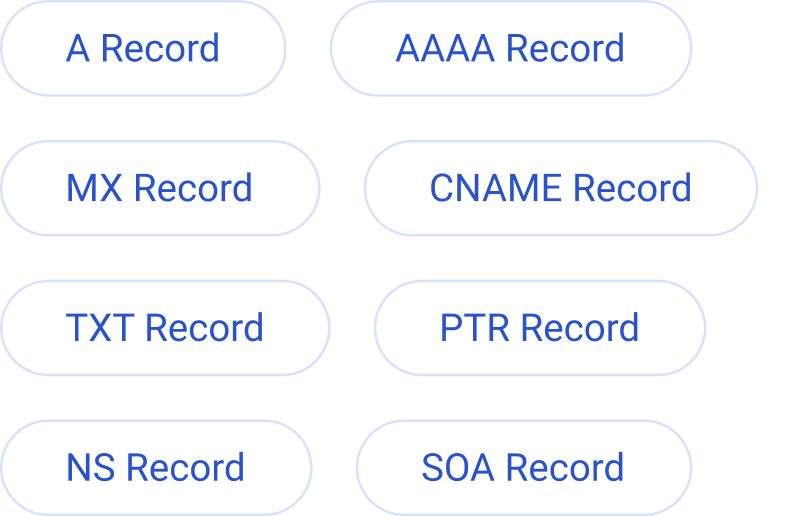CNAME Record Lookup
Use our CNAME lookup tool by entering your domain or IP and the DNS server hosting it.
Check DNS Records Across Your Domain
A canonical name record, or CNAME record, is used in place of an A record when a domain or subdomain is an alias of another. The CNAME record points from the alias domain to a canonical domain. Think of it like a scavenger hunt, where each clue points to another clue; a CNAME record is like one of these clues that eventually leads to a domain with an A record.
CNAME records are often used when sites have subdomains like blog.google.com so that if the IP address of the host changes, only the DNS A record needs to be changed. All CNAME records will follow along without the need to change each individual domain. A CNAME lookup can tell you what domains the CNAME is pointing to in order to help you verify the integrity of the CNAME chain.
CNAME records are also used in managed DNS setups to simplify configuration and updates. With our managed solutions (like DMARC, BIMI, and MTA-STS), customers only need to add a single CNAME record in their DNS once.
For example: _dmarc.example.com pointing to _dmarc.example.easydmarc.com.
This removes the need for customers to manually modify their DNS for every update while keeping full visibility and control with just a few clicks, allowing policy and record changes to be managed directly from our platform.
For more helpful DNS tools, check out our dns lookup tool and ns lookup pages.

What DNS Records can be found with EasyDMARC
Our DNS Lookup Tool allows you to check and validate key DNS record types, making it easier to manage your domain’s configuration. Here's what it supports:
- A Record – Links your domain to an IPv4 address
- AAAA Record – Connects your domain to an IPv6 address
- MX Record – Routes email messages to your domain’s mail server
- CNAME Record – Sets up an alias from one domain to another
- TXT Record – Holds text used for domain verification and authentication
- PTR Record – Enables reverse lookup from an IP address to a domain name
- NS Record – Identifies the name servers responsible for your domain
- SOA Record – Provides key administrative data and authority details for the DNS zone
By reviewing these records, our tool helps ensure your DNS settings are accurate and your domain functions reliably.

How EasyDMARC CNAME Checker Works
Looking up your CNAME records is easy with EasyDMARC’s CNAME Lookup Tool:
- Enter your IP or Domain – Input the domain name or IP address of your alias domain.
- Pick the DNS Server – Choose one of many well-known servers like Google, Cloudflare, Quad9, or choose your domain’s authoritative name server (SOA).
- View the Results – All available information on your CNAME records and domain will be displayed with more detailed analysis available.
You can check CNAME records easily after our tool analyses and collects all CNAME record information. Use these records to understand your domain configuration and correct errors if they exist.

What is a CNAME record used for?
A CNAME (Canonical Name) record is used in DNS (Domain Name System) to map one domain name to another. It's typically used to alias one domain to another, making it easier to manage multiple domain names. For example, you could point "www.example.com" to "example.com" or set up subdomains like "blog.example.com" to point to a different server or service. Essentially, it helps in redirecting traffic from one domain to another without changing the IP address.
Why use CNAME instead of A Records?
While it is important to note that you cannot replace a CNAME record with an A record, CNAME records are most often used instead of A records for the following reasons:
Easier management:
CNAME: It allows you to alias one domain to another, so if the target domain's IP address changes, you don’t have to update each individual subdomain. Instead, you only need to update the IP address of the canonical domain.
A record: Each A record points directly to an IP address, so if the IP address of a service or server changes, you'd need to update all A records that reference that IP.
Reduces redundancy:
CNAME: By using a CNAME, you can manage a single IP address for multiple subdomains. This helps prevent the need to update each subdomain individually.
A record: If you use A records for each subdomain (e.g., "www" and "blog"), they all need to be updated separately if the IP changes.
Simpler for subdomain redirection:
CNAME: Ideal for scenarios where you want to redirect subdomains to an external service, like pointing "www.example.com" to "example.com" or using "blog.example.com" to redirect to a blog hosted on a different platform.
A record: This is not suitable for such redirection scenarios.
Avoids IP conflicts:
CNAME: Using CNAME avoids potential issues of having multiple A records pointing to different IP addresses for the same domain.
A record: If there are conflicting IP addresses, it can create confusion in the DNS lookup process.
What is the role of CNAME?
A CNAME record maps one domain name to another, acting as an alias. It simplifies domain management by allowing subdomains like "www.example.com" to point to the main domain, such as "example.com." This way, if the IP address changes, only the main domain needs to be updated, and all CNAME-aliasing subdomains follow the change. It also facilitates domain redirection and is commonly used in cloud services or to point subdomains to external platforms.
Is a CNAME just a redirect?
A CNAME is similar to a redirect, but it's not the same. While both guide traffic from one domain to another, a CNAME works at the DNS level by mapping one domain name to another. This means that when someone visits a CNAME domain, the DNS resolves it to the target domain.
In contrast, a typical redirect (such as HTTP 301 or 302) occurs at the web server level, redirecting the user to a different URL in their browser. So, while a CNAME changes the domain resolution, a redirect changes the user's location after they've reached the site.
How to check CNAME records?
To check CNAME records, you can use various methods, including command-line tools and online DNS lookup services.
For Windows, you would open Command Prompt and run (nslookup -type=CNAME <domain-name>), ignoring the parenthesis.
For MacOS or Linux, you would open Terminal and run (dig <domain-name> CNAME) again ignoring the parentheses.
Alternatively, EasyDMARC.com makes looking up CNAME records easy, straightforward, and beginner friendly. Simply open the CNAME checker tool, put in the domain host and domain or IP address, and click “Lookup CNAME.”

